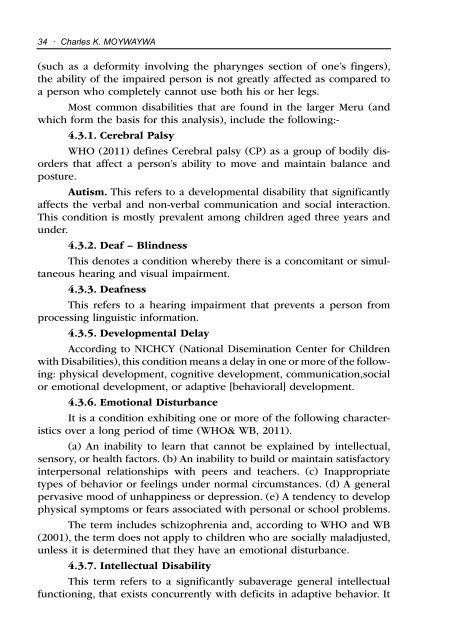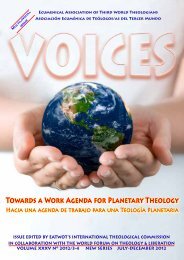voices-2013-2&3 - EATWOT's International Theological Commission
voices-2013-2&3 - EATWOT's International Theological Commission
voices-2013-2&3 - EATWOT's International Theological Commission
You also want an ePaper? Increase the reach of your titles
YUMPU automatically turns print PDFs into web optimized ePapers that Google loves.
34 · Charles K. MOYWAYWA(such as a deformity involving the pharynges section of one’s fingers),the ability of the impaired person is not greatly affected as compared toa person who completely cannot use both his or her legs.Most common disabilities that are found in the larger Meru (andwhich form the basis for this analysis), include the following:-4.3.1. Cerebral PalsyWHO (2011) defines Cerebral palsy (CP) as a group of bodily disordersthat affect a person’s ability to move and maintain balance andposture.Autism. This refers to a developmental disability that significantlyaffects the verbal and non-verbal communication and social interaction.This condition is mostly prevalent among children aged three years andunder.4.3.2. Deaf – BlindnessThis denotes a condition whereby there is a concomitant or simultaneoushearing and visual impairment.4.3.3. DeafnessThis refers to a hearing impairment that prevents a person fromprocessing linguistic information.4.3.5. Developmental DelayAccording to NICHCY (National Disemination Center for Childrenwith Disabilities), this condition means a delay in one or more of the following:physical development, cognitive development, communication,socialor emotional development, or adaptive [behavioral] development.4.3.6. Emotional DisturbanceIt is a condition exhibiting one or more of the following characteristicsover a long period of time (WHO& WB, 2011).(a) An inability to learn that cannot be explained by intellectual,sensory, or health factors. (b) An inability to build or maintain satisfactoryinterpersonal relationships with peers and teachers. (c) Inappropriatetypes of behavior or feelings under normal circumstances. (d) A generalpervasive mood of unhappiness or depression. (e) A tendency to developphysical symptoms or fears associated with personal or school problems.The term includes schizophrenia and, according to WHO and WB(2001), the term does not apply to children who are socially maladjusted,unless it is determined that they have an emotional disturbance.4.3.7. Intellectual DisabilityThis term refers to a significantly subaverage general intellectualfunctioning, that exists concurrently with deficits in adaptive behavior. It





